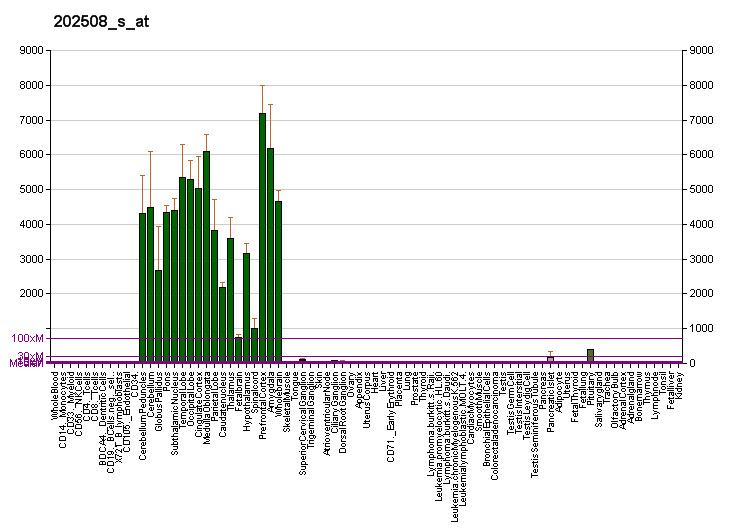Entrez 6616 | Ensembl ENSG00000132639 | |
 | ||
Aliases SNAP25, CMS18, RIC-4, RIC4, SEC9, SNAP, SNAP-25, bA416N4.2, dJ1068F16.2, SUP, synaptosome associated protein 25kDa, synaptosome associated protein 25 External IDs OMIM: 600322 MGI: 98331 HomoloGene: 13311 GeneCards: SNAP25 | ||
Synaptosomal-associated protein 25 (SNAP-25) is a t-SNARE protein that is encoded by the SNAP25 gene in humans. SNAP-25 is a component of the trans-SNARE complex, which is proposed to account for the specificity of membrane fusion and to directly execute fusion by forming a tight complex that brings the synaptic vesicle and plasma membranes together.
Contents
Structure and function
SNAP-25, a Q-SNARE protein, is anchored to the cytosolic face of membranes via palmitoyl side chains covalently bound to cysteine amino acid residues in the middle of the molecule. This means that SNAP-25 does not contain a trans-membrane domain.
SNAP-25 has been identified in contributing two α-helices to the SNARE complex, a four-α-helix domain complex. The SNARE complex participates in vesicle fusion, which involves the docking and merging of a vesicle with the cell membrane to bring about an exocytotic event. Synaptobrevin, a protein that is a part of the vesicle-associated membrane protein (VAMP) family, and syntaxin-1 also help form the SNARE complex by each contributing one α-helix. SNAP-25 assembles with synaptobrevin and syntaxin-1 and the selective binding of these proteins enables vesicle docking and fusion to occur at the correct location.
To form the SNARE complex, synaptobrevin, syntaxin-1, and SNAP-25 associate and begin to wrap around each other to form a coiled coil quaternary structure. The α-helices of both synaptobrevin and syntaxin-1 bind to those of SNAP-25. Synaptobrevin binds the α-helix near SNAP-25's C-terminal side, while syntaxin-1 binds the α-helix near the N-terminus.
SNAP-25 inhibits presynaptic P-, Q-, and L-type voltage-gated calcium channels and interacts with the synaptotagmin C2B domain in Ca2+-independent fashion. In glutamatergic synapses, SNAP-25 decreases the Ca2+ responsiveness, while it is naturally absent in GABAergic synapses.
Two isoforms (mRNA splice variants) of SNAP-25 exist, which are labeled A and B. There are nine amino acid residue differences between the two isoforms, including a re-localization of one of the four cysteine residues. The major characteristics of these two forms are outlined in the table below.
Clinical significance
Consistent with the regulation of synaptic Ca2+ responsiveness, heterozygous deletion of the SNAP-25 gene in mice results in a hyperactive phenotype similar to attention deficit hyperactivity disorder (ADHD). In heterozygous mice, a decrease in hyperactivity is observed with dextroamphetamine (or Dexedrine), an active ingredient in the ADHD drug Adderall. Homozygous deletions of the SNAP-25 gene are lethal. Subsequent studies have suggested that at least some of the SNAP-25 gene mutations in humans might predispose to ADHD.
A genome wide association study pointed to the rs362584 polymorphism in the gene as possibly associated with the personality trait neuroticism. Botulinum toxins A, C and E cleave SNAP-25, leading to paralysis in clinically developed botulism.
Interactive pathway map
Click on genes, proteins and metabolites below to link to respective articles.
Interactions
SNAP-25 has been shown to interact with:
